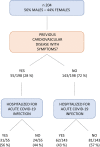Symptomatic post COVID patients have impaired alveolar capillary membrane function and high VE/VCO2
- PMID: 38331869
- PMCID: PMC10851544
- DOI: 10.1186/s12931-023-02602-3
Symptomatic post COVID patients have impaired alveolar capillary membrane function and high VE/VCO2
Abstract
Background: Post COVID-19 syndrome is characterized by several cardiorespiratory symptoms but the origin of patients' reported symptomatology is still unclear.
Methods: Consecutive post COVID-19 patients were included. Patients underwent full clinical evaluation, symptoms dedicated questionnaires, blood tests, echocardiography, thoracic computer tomography (CT), spirometry including alveolar capillary membrane diffusion (DM) and capillary volume (Vcap) assessment by combined carbon dioxide and nitric oxide lung diffusion (DLCO/DLNO) and cardiopulmonary exercise test. We measured surfactant derive protein B (immature form) as blood marker of alveolar cell function.
Results: We evaluated 204 consecutive post COVID-19 patients (56.5 ± 14.5 years, 89 females) 171 ± 85 days after the end of acute COVID-19 infection. We measured: forced expiratory volume (FEV1) 99 ± 17%pred, FVC 99 ± 17%pred, DLCO 82 ± 19%, DM 47.6 ± 14.8 mL/min/mmHg, Vcap 59 ± 17 mL, residual parenchymal damage at CT 7.2 ± 3.2% of lung tissue, peakVO2 84 ± 18%pred, VE/VCO2 slope 112 [102-123]%pred. Major reported symptoms were: dyspnea 45% of cases, tiredness 60% and fatigability 77%. Low FEV1, Vcap and high VE/VCO2 slope were associated with persistence of dyspnea. Tiredness was associated with high VE/VCO2 slope and low PeakVO2 and FEV1 while fatigability with high VE/VCO2 slope. SPB was fivefold higher in post COVID-19 than in normal subjects, but not associated to any of the referred symptoms. SPB was negatively associated to Vcap.
Conclusions: In patients with post COVID-19, cardiorespiratory symptoms are linked to VE/VCO2 slope. In these patients the alveolar cells are dysregulated as shown by the very high SPB. The Vcap is low likely due to post COVID-19 pulmonary endothelial/vasculature damage but DLCO is only minimally impaired being DM preserved.
Keywords: Cardiopulmonary exercise test; Covid-19; Lung diffusion; Post COVID; Post-COVID-19 syndrome.
© 2024. The Author(s).
Conflict of interest statement
The authors declare that they have no competing interests.
Figures



